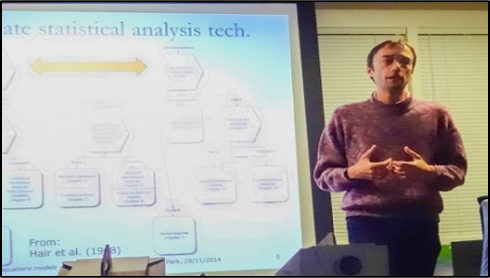 |

|
 |
Dr. Marco Diana from Politecnico di Torino, Italy |
|
On October 29, 2014, 3:00-5:30 pm, as one of the ITS/ITE MD Student Chapter speaker seminars sponsored by the National Transportation Center @ Maryland, Dr. Marco Diana from Department of Transport Engineering and Planning at Politecnico di Torino, Italy, gave a presentation in the CEE Conference Room, 1179 Glenn Martin Hall. The topic is “Structural equation models: Opportunities, risks and discussion of some applications in the travel behavior research domain”.
Marco Diana's talk to the ITS-ITE Maryland student chapter gave an in-depth overview of structural equation models (SEM). This type of model combines a standard regression model (the "structural" part) with a factor model (the "measurement" part) and the two sub-models are estimated jointly. In the measurement model, latent variables -- which are either chosen a priori by the engineer ("confirmatory analysis") or discovered a posteriori through the technique itself ("exploratory analysis") -- summarize groups of correlated observed variables. The observed variables are regressed on the latent variables, and the coefficients are called the loadings. SEM modeling has several key benefits over standard regression modeling: (1) the error terms do not have to be uncorrelated (no homoscedasticity assumption), (2) there can be multicollinearity (correlation) among the observed variables (this is in fact desired for SEM) and (3) it allows for the estimation of the measurement error.
A survey of the applications of SEM models in the transportation field has been done by TF Golob, 2003 (link to free version from 2001). Applications include activity-based models, modeling mode choice behavior, car ownership and use determinants, and travel attitudes. Since there is no homoscedasticity assumption, SEM models are often useful when dealing with panel and longitudinal data. Diana presented results from his paper on a primary utility model based on French survey data. As opposed to an activity-based model, a primary utility model can separate the utility of the activity at the destination and the utility of traveling to the destination. The overall enjoyment of the trip is a latent variable that summarizes different factors, such as for instance, were there others traveling with you, was the vehicle comfortable, etc. The result of the paper was a 1-10 score of the time spent traveling for each individual, and it was shown that drivers enjoyed their trips more than transit riders, and non-commuters more than commuters.
Diana also presented the various software packages that can be used for SEM modeling, and gave warning that these models must be applied with expertise. He gave guidelines on the number of observations needed to avoid under or over-fitting. Other potential pitfalls include lack of convergence in the estimation, estimates for variance that are negative, or for loadings that are greater than 1. However, when applied correctly, the model can be extremely informative.
Marco Diana is an Associate Professor of Transport Engineering and Planning at Politecnico di Torino, Italy. Before his actual position, he was a visiting scholar at the University of Southern California (Los Angeles) and completed a postdoc at the French National Institute for Transport and Safety Research (INRETS, now IFSTTAR). His works have focused on the identification of information and communication technologies impacts on transport systems, the analysis of innovative mobility services and the study of multimodality behaviours through advanced data exploitation techniques. He explored the use of a wealth of analytical methods in travel behavior research, including multivariate statistical analyses (factor analysis, cluster analysis, regression), structural equation models and data mining techniques (association analyses, sequential patterns). His activity has been funded through a variety of sources (EU-FP7, national programmes, university grants) and is documented in about 50 publications, many of which published in outstanding scholarly journals.
The presentation file can be downloaded here.
November 3, 2014
|

